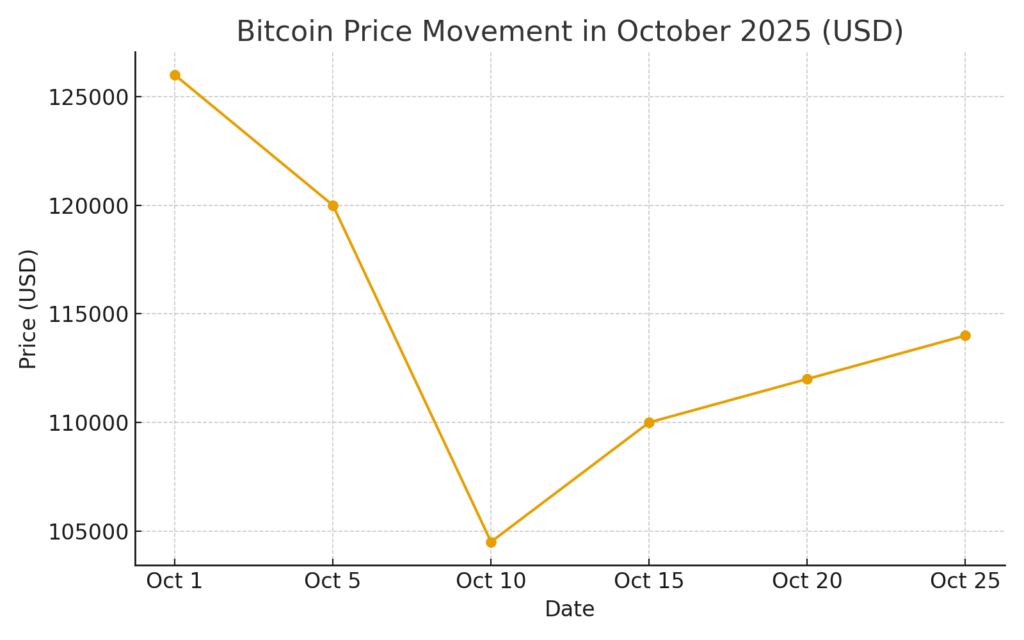
Main Points :
- A provisional U.S.–China trade agreement is on the table, potentially easing a major geopolitical risk and acting as a catalyst for higher bitcoin (BTC) prices.
- On the Deribit exchange, the bias in bitcoin options has shifted: put-option (downside protection) demand has weakened, suggesting less hedging and growing confidence in upside.
- Despite elevated open interest in bitcoin options (calls clustering around high strikes) suggesting bullish sentiment, systemic risk remains from macro events and leverage unwinds.
- Derivatives data show that although many traders remain cautious (heavy put-skew), some institutional positioning is accumulating toward $140,000 strikes for bitcoin.
- The crypto market remains sensitive to trade-war headlines and liquidity shifts—so for those hunting the next crypto leg up or new revenue opportunities, now subtle structuring of position may matter.
- Practical takeaway for blockchain/crypto infrastructure players: when macro risk recedes, capital often rotates into digital-asset setups, meaning those ready with UX, payments, or chain integration may be ahead of the crowd.
1. Geopolitical Flashpoint: U.S.–China Trade and Its Crypto Implications
The backdrop to the recent market action is the unfolding trade discussions between the U.S. and China. According to reports, a provisional trade deal between Donald Trump and Xi Jinping is driving optimism that one of the largest macro risk overhangs in recent years may ease. The mere hint of cooperation has already stirred expectations of a risk-on rotation into assets like bitcoin.
The logic: as trade tensions fall, capital shifts out of safe-haven modes and speculative infrastructure (digital assets, blockchain plays) benefit. For crypto investors seeking the next revenue stream, this is meaningful. If the geopolitical backdrop improves, bitcoin could be the beneficiary of both sentiment flows and derivatives positioning.
Historically, bitcoin has been reactive to macro tail events. For example, the October 10 sell-off in bitcoin followed fresh tariffs announced by the U.S., and later, crypto markets tumbled as tensions flared anew.
Conversely, when risk recedes, the implied upside becomes more attainable—derivatives markets are already reflecting this through open interest clusters around high strike calls (we’ll get to that below).
For blockchain infrastructure players, this trade environment suggests timing matters: when the macro risk curtain lifts, more capital flows into the rails (wallets, swaps, bridges). Being prepared now may yield outsized advantages.
2. Bitcoin Options & Derivatives: What Data from Deribit and Others Reveal
One of the most interesting lenses into investor sentiment is options markets—especially for bitcoin. Let’s unpack what the data are telling us:
(a) Put-skew weakening

On Deribit, the premium for put-options (protection against price drops) relative to calls has shrunk. According to market-data tracked by Amberdata and referenced in Deribit analytics, after the October 10 crash triggered by tariff threats, the call/put volatility premium (the extra one pays for puts) fell from ~5 % to ~2–3 %. This suggests traders are less fearful of downside and more comfortable with a base or upside scenario.
(b) Elevated open interest and bullish call clustering

According to Bloomberg data, open interest for bitcoin calls (betting on an upside to e.g. US$140,000) has shot up.
Further, Deribit’s own executive commentary indicates that institutional positioning is increasingly tilted toward upside, with calls accounting for roughly 59.8 % of open interest versus 40.2 % for puts.
This indicates that some of the “smart money” is speculating on a higher bitcoin price rather than simply hedging a drop.
(c) Skew and implied volatility behaviour
Weekly analytics from Deribit show that in recent weeks, bitcoin’s short-term volatility expectations remain historically low, even as longer-term calls dominate flows. Meanwhile, the traditional put-skew remains (i.e., out-of-the-money puts are still priced at a premium), but the gap is narrowing.
In simpler terms: the market is still aware of downside risk, but is increasingly eyeing upside.
Interpretation for investors
If you’re hunting for new crypto revenue opportunities or looking to position infrastructure (wallets, swaps, bridges), this derivatives dynamic provides clues:
- A less-skewed market suggests potential for stronger upside rhythm ahead.
- Elevated call open interest at high strikes means there is a “bet” on upside that could become self-fulfilling if flows follow.
- However, the system remains levered and macro risk remains real—so infrastructure providers should prepare for both upside and turbulence.
3. The Price Action: Bitcoin’s Movement in the Context of Macro Events

According to multiple sources, bitcoin’s trajectory in October 2025 has been volatile and tightly linked with macro headlines.
- At the start of the month, bitcoin traded near US$126,000, a record high.
- After tariff announcements and trade-war escalation, bitcoin fell to lows near US$104,500—a drop of roughly 14 %.
- Following that crash, the market has shown partial rebound and consolidation in the US$110,000–US$115,000 range.
- Notably, the derivatives advanced above suggest that many traders see the next meaningful upside target around US$140,000.
For those in crypto infrastructure: when price is this volatile and macro-driven, adoption momentum and swirl of flows matter. If bitcoin establishes a base and flows rotate in, the period could mark a broader market move into adjacent assets and protocols.
4. Implications for New Crypto Assets and Blockchain Infrastructure
Given the above derivatives and macro context, what does this mean for the audience seeking new crypto assets or practical blockchain applications?
A. Opportunity Zone for Altcoins and Emerging Protocols
If bitcoin rallies, often there is a “spill-out” effect: capital rotates into smaller-cap tokens, DeFi, layer-2 chains, and payment-infrastructure stacks. With macro risk reducing, this spill-out could intensify.
B. Non-custodial wallets and UX readiness
Given you’re developing a wallet (non-custodial, allowing BTC⇄ETH swaps), this environment could be timely. As capital rotates and flows increase, wallet UX, fast settlement, and transparent swap execution become differentiators.
C. Derivative sensitivity means infrastructure services matter
The fact that options markets are factoring upside means that derivatives and hedging flows are alive again. Infrastructure that supports options, hedging, staking, or capital-rotation may see increased demand.
D. Timing matters, but risk remains
While the trade-deal optimism is a catalyst, it is not a guarantee. The risk of renewed trade war, regulatory shock, or leveraged unwind remains. Therefore, for protocol/infrastructure builders, preparing for both upside expansion and operational resilience in stress is prudent.
5. Strategy and Practical Takeaways for Stakeholders
Here are actionable takeaways for those reading this article seeking income, blockchain applications, or crypto investments:
- Consider positioning early in infrastructure: If you build wallets/exchanges or offer novel swaps, now is a good time to refine UX, settle compliance, optimize fees—not after flows arrive.
- Monitor derivatives flows: When put-skew narrows and call open interest rises, that’s a sign sentiment may be shifting.
- Keep macro risk radar on: U.S.–China diplomacy, rare-earth export controls, tariff announcements—all impact crypto flows. These are not niche events—they drive major liquidations.
- For new assets: if bitcoin clears a significant resistance (say toward US$140,000), many emerging tokens could benefit; be ready with scouting, research, and perhaps early-access infrastructure.
- For wallet/chain swaps: ensure you support volatility spikes and liquidity moves—users might demand quick swaps or hedging tools as flows rotate.
- Remember liquidity risk: The October crash that wiped ~$19 billion plus in liquidations shows that infrastructure must handle stressed exits and sudden deluge of volumes.
Conclusion
The intersection of macro events (U.S.–China trade talks), derivatives indicators (put‐skew narrowing, calls clustering high), and bitcoin price action suggests we may be at the cusp of a meaningful move in digital assets. For those hunting new crypto revenue sources, blockchain application opportunities, or next-gen non-custodial wallet architecture, this constellation matters.
If the trade risk recedes and bitcoin begins to rally toward the US$140,000 zone, infrastructure built now may capture outsized flows. But the risk textbook has not changed: macro turbulence, leverage unwind, and institutional flows still dominate. Build for both upside and survival.
In short: This is not merely about buying bitcoin—it’s about positioning in the rails, tools, and flows that will carry the next leg of adoption. For the strategic crypto builder or investor, this window may be fertile.

